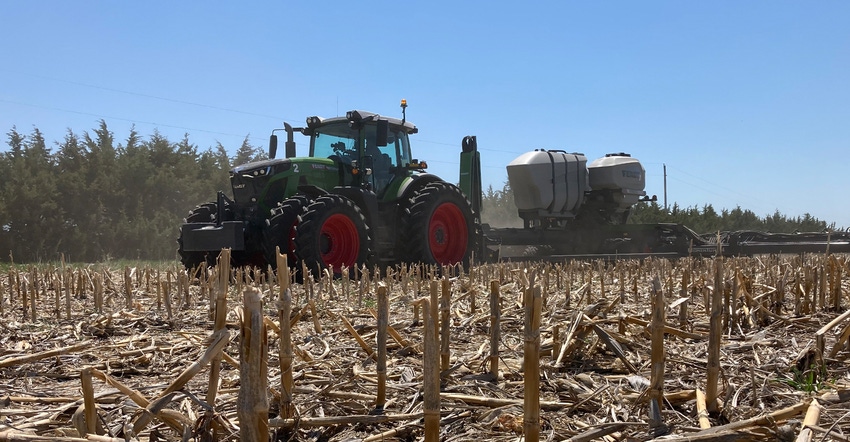
Despite a rainy end to May, the state of Kansas is still facing widespread drought across the western two-thirds of the state.
According to the U.S. Drought Monitor, a strong upper-level trough moved across the contiguous U.S. the week of May 18-24. It brought surface low pressure systems and cold fronts, and the complex trough tapped Gulf of Mexico moisture to spread above-normal precipitation across parts of the Plains. Two inches or more of precipitation fell across southern and eastern parts of Kansas, central Colorado and northeast Nebraska, while half an inch or more was widespread across North Dakota. This was just enough to bring optimism to spring planting.
Kansas State University agronomy experts have advice for these farmers racing to the field to manage their herbicide applications and their fall crops.
Herbicides in corn
Sarah Lancaster, K-State Extension weed science specialist, and Jeanne Falk Jones, multicounty agronomy specialist, warn corn farmers to be sure to not get too far ahead of the sprayer to ensure the full effectiveness of their preemergence herbicide applications.
“The speed of planting coupled with unusually windy conditions can potentially interfere with preemergence herbicide applications,” the two write in the May 12 Agronomy eUpdate.
Residual herbicides are the foundation of weed management programs, according to Lancaster. Fortunately, many residual products that are applied preemergence to corn, can also be applied to small corn. These include:
Atrazine
Group 15 herbicides such as acetochlor (Harness, Warrant, others), dimethenamid-P (Outlook, others), pyroxasulfone (Zidua, others) and S-metolachlor (Dual, others)
Group 27 herbicides such as isoxaflutole (Balance Flexx, others) and mesotrione (Callisto, others)
Premixes that contain various combinations of these products, such as Acuron, Anthem, Armezon Pro, Corvus, Lumax or Lexar, Resicore and SureStart II.
If you’re in a situation where you need to apply a weed control product to emerged corn, do not use any products that contain flumioxazin, like Valor, according to Lancaster. And if you’re considering making an application to control emerged weeds in the field, remember paraquate, saflufencail and tiafenacil cannot be safely applied to emerged corn.
Also, be wary of activation requirements for the products you do apply, since Kansas may be facing drier-than-normal conditions that continue through the summer, Lancaster and Jones advise.
Herbicides in cotton
Kansas farmers who are new to planting cotton must remember that unlike other fall crops they may be used to, cotton can be slower to canopy — and that makes early-season weed control all the more critical. According to Lancaster and Stu Duncan, retired K-State Extension crops and soils specialist, weeds not only rob cotton of water, nutrients and sunlight, but they can also contribute to trash and lint discoloration at harvest. That can reduce the value of the lint from docked quality grades.
While farmers to the south may use tillage in their early-season weed control toolbox, the majority of Kansas cotton acres are in conservation tillage. That calls for effective burndown herbicide applications before planting, and residual herbicides applied at planting to manage or delay the development of herbicide-resistant weed populations.
Read more about Lancaster and Duncan's recommendations.
Volunteer corn in soybeans
Volunteer corn plants can be much more of a nuisance than just sticking out like a sore thumb in an otherwise beautiful soybean field. Lancaster says research from South Dakota puts soybean yield loss at 8% to 9% when volunteer corn density was at just one plant per 10 square feet. “Yield loss increased to 71% at volunteer corn densities of about one plant per square foot,” she writes in the May 19 Agronomy eUpdate.
How do you manage volunteer corn when it very well may be resistant to glyphosate or glufosinate? You have three chances:
1. Burndown. Paraquat products will control volunteer corn that has emerged prior to soybean planting. Glufosinate will also do the trick, as long as the corn is not a glufosinate-resistant variety like LibertyLink. To achieve full effect, apply burndown herbicide in contact with the growing point on the corn, so make sure it is at V6 stage at least.
2. At planting. University of Nebraska research shows that preemergence applications of sulfentrazone in combination with imazethapyr, cloransulam, metribuzin or chlorimuron (Authority Assist, Authority First, Authority MTZ or Authority XL) reduced volunteer corn growth compared to non-treated controls.
3.Over the top. If you’re delayed, you still have an option to use Group 2 herbicides for very effective over-the-top options for volunteer corn control in soybeans. Just be sure to use the maximum labeled rate, or use a more aggressive adjuvant.
You can read more in the May 19 Agronomy eUpdate.
Kansas State Research and Extension contributed to this article.
About the Author(s)
You May Also Like






